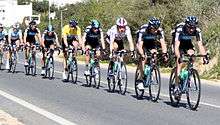Peloton
The peloton (from French, originally meaning 'platoon') is the main group or pack of riders in a road bicycle race. Riders in a group save energy by riding close (drafting or slipstreaming) near (particularly behind) other riders. The reduction in drag is dramatic; in the middle of a well-developed group it can be as much as 40%.[1]
The term is also used to refer to professional cyclists in general.
Definition

The peloton travels as an integrated unit (similar in some respects to birds flying in formation) with each rider making slight adjustments in response to their adjacent riders (particularly the one in front of each). When developed, riders at the front are exposed to higher loads, and will tend to slip off the front in order to rejoin the pack farther back. With sufficient room to maneuver, this may develop into a fluid situation where the center of the peloton appears to be pushing through its own leading edge.
The shape or formation of the peloton changes according to many factors. A strong headwind or a hard effort tends to spread out or string out the riders, while a slow tempo or tailwind tends to bunch up the peloton into a wider formation. Side wind forces the peloton to form into echelons in the direction of the wind. Often, the width of the road forces the peloton to form several echelons. When two or more groups of riders want to contest control of the peloton, several lines may form racing one another.
While only the riders exposed to the wind, at the front and on the windward side when there is a significant crosswind, are the ones doing the most work, it is usually advantageous to be closer to the front of the peloton. One reason is to avoid being affected by the 'elastic band effect' in which a change in speed becomes amplified as it propagates to the back of the peloton. The rider riding behind a rider who is changing his/her speed must make the adjustment at a slightly faster rate (due to reaction time) to avoid collisions.
Moreover, being closer to the front means that the rider can react to attacks and changes in position with less effort. Gaps sometimes form in the peloton, and being closer to the front reduces the risk of getting caught in the rear group when the peloton breaks form. This is especially true in strong crosswind conditions. It's important for riders in contention to be nearer the front on flat road with approaching sharp turns that have to be taken more slowly. Accelerating off of sharp turns into changing wind conditions is where the peloton is most likely to stretch to a breaking point. Once a split occurs and if the collective strength of a front group is greater than that of the rear group it is very hard to bridge from the back group as a single rider. The effort expended bridging over from one large group to another puts a rider at a distinct disadvantage compared to those aerodynamically protected in a larger front group and often plays a large factor in the outcome of a race. The aerodynamic advantage of riding in a large group is so distinct that even the most talented riders find it extremely difficult to bridge a gap back to the front group while breaking the wind alone when speeds are high and the road is flat. Also, the risk of ending up in a crash declines when nearer to the front, because the front riders have the fewest fallen riders to evade. Being at the front of the peloton means dictating the tempo to some degree, and some teams or groups of riders may prefer different speeds as part of their tactics. Being at the front of the peloton is also advantageous when initiating a breakaway.
Tactical factors also apply.[2] Teams generally attempt to cluster their members in the peloton in order to maximize their ability to affect the pack as a whole. For instance, if a team member is currently on a breakaway in front of the peloton, it is advantageous for the remaining members to slow the peloton as much as possible in an attempt to avoid catching the breakaway. This can be particularly effective in tight turns or narrow roads, where a single team can block the progress of the pack if they are in a favorable position. A similar situation occurs at the end of the race when teams will cluster in front of their sprinter, blocking the wind as long as possible while still leaving an open path in front for the sprinter to break out near the finish line. More often than not a small group that may have gained an advantage earlier is caught by the larger group chasing them. This is especially true when the chasing group is led by the teams of the best sprinters who come to the front and form echelons to maximize their aerodynamic advantage of the larger chasing group.
It is typical for large hills to split up pelotons, as the aerodynamic factors are much less important at slower climbing speeds and power-to-weight ratio is the key determinant of speed.
See also
References
- ↑ Burke, Edmund (2003). High-Tech Cycling.
- ↑ Macur, Juliet (2009-07-06). "Sixth Sense Has Armstrong in Third Place". New York Times. Archived from the original on 2011-07-20.
External links
| Wikimedia Commons has media related to Peloton. |
- Hochman, Paul (2006-06-01). "Pack mentality". Fortune. New York City: Time Inc. ISSN 0015-8259.
Cut deals with the enemy, maximize liquidity, punish the welshers, and other free-market lessons of the typical bike race.
- Miller, John W. (2010-07-23). "When the Middle of the Pack Is Good". The Wall Street Journal. New York City: Dow Jones & Company. ISSN 0099-9660.
At Tour de France, the Peloton Shields Top Riders, but It Comes With Rules; 'Moving Community'